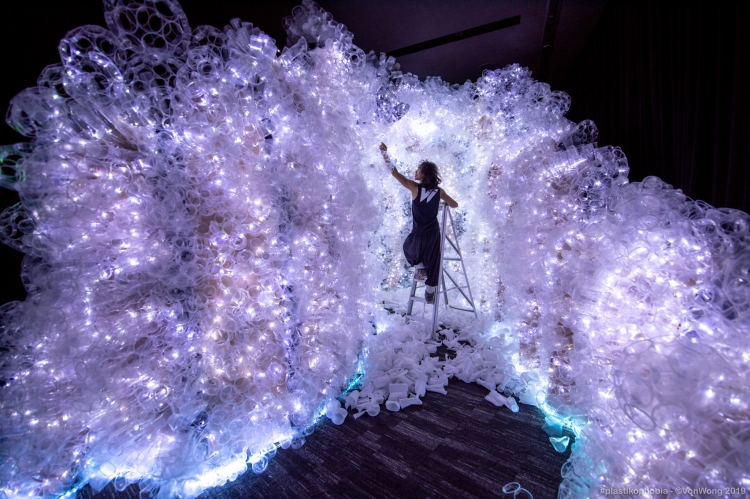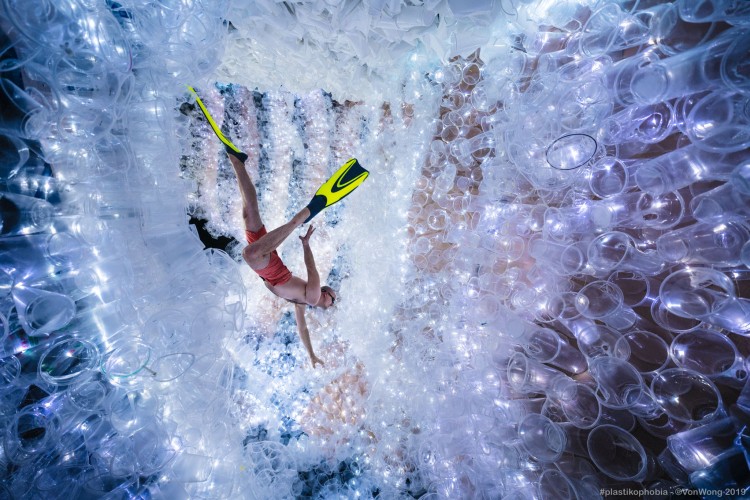
This article was first published in The New York Times Style Magazine on 19 March 2019.
A new visual vernacular is now sitting within the premises of the Sustainable Singapore Gallery in Marina Barrage. Opened a fortnight ago, the immersive installation, entitled ‘Plastikophobia’, stands 3.5 metres tall and is made of 18,000 plastic cups.
The brainchild of Canadian viral photographer and artist Benjamin Von Wong, who was invited by the High Commission of Canada, and Singapore-based social impact strategist Laura A. François, the installation is glittered with LED fairy lights and resembles a cosmic cavernous grotto that is imbued with elements of trypophobia — an aversion to clusters of small holes — and claustrophobia.
“[Laura and I] tried to conceptualise something that could have a hint of different phobias,” Von Wong explains. “We wanted to create a new word, one that describes a phobia of plastic. It hasn’t been created yet. So, this is an opportunity to bring in a new word into the lexicon and hopefully encourage more people to be aware of plastics.”

The duo, with the aid of the National Environmental Agency, collected 18,000 used plastic cups from just 24 hawker centres around Singapore, a staggering denomination accrued over a mere span of one and a half days. In the 10 days that followed, they and 75 volunteers banded together to sort, wash, and melt the plastic cups, which are plastered onto multiple upcycled wooden panels with glue and staples.
“These are takeaway cups that are never even taken away; all of them were collected in dine-in settings We purposely burned holes into many of the cups to remind the public that Singapore still incinerates most of its waste,” Laura says. “The waste strategy in Singapore has been based on burning, and not on reusing.”
In a report published by the Ministry of the Environment and Water Resources in 2018, only six percent of all plastic waste was recycledin 2017. A large bulk of the non-recyclable waste is, as Von Wong says it, “turned to the incinerator”.
As authorities attribute contamination of plastic disposables from food and liquid waste in blue recycling bins amongst the culprits, the discourse on whether Singaporeans are harbouring flippant attitudes towards recycling surfaces.

“Large scale problems like plastic pollution are systematic. It’s not fixed by a single ban or policy, but rather a collaboration of changes across all sectors. We, as the public, need to play our part in curbing our consumption, learning how to recycle properly and start demanding those changes,” Laura says.
With 2019 being designated as Singapore’s Year Toward Zero Waste, the nation is relooking at reworking food, electronic, and packaging waste management to reduce carbon footprint. The ‘Plastikophobia’ installation has never been timelier.
For many, walking through the man-made installation is an overwhelming sensation. On one hand, it sheds light — very literally too — on the egregious consumption of single-use plastics, and on the other, the sense of constriction is unequivocally dizzying and discomforting.
“I really wanted people to realise that these take-out cups are completely unnecessary. If one person lives for 30,000 days out of his life and if he uses one cup a day, that’s 30,000 cups. That’s how much one single individual can affect the world,” Von Wong explains.
Von Wong, however, was quick to add that the process of constructing the piece was not a smooth-flowing one. While attempting to stay true to the greater narrative of invoking a subtle sense of fear and discomfort, the installation, at one point in time, was, according to Von Wong, “too pretty”.
“I started to remember that at the end of the day, it’s not a bad thing that it looks pretty. If anything, it still ties strongly to the message. There was nobody telling us how this should look like, and really it was just how we were going to tell the story,” he explains.

Environmental conservation and waste crisis are constant themes that appeared in Von Wong’s works. In 2018, the 32-year-old artist partnered with Dell to transmogrify 4,100 pounds of e-waste into three stunning landscapes. And earlier this year, he used 168,000 single-use plastic straws to form a 3.3 metres tall art installation in Vietnam and clinched a Guinness World Record for the World’s Largest Drinking Straw Sculpture. “It’s always cool to be awarded and I feel super proud about it. At the end of the day, it’s about how many hearts and minds [each installation] touches, whether or not it helps affect the policies — those are the things we truly care about.” Von Wong says.
In recent times, the rising crescendo of interest in reducing plastic waste has spurred organisations and individuals to take up conservation projects and pledge to reduce plastic consumption. In the Netherlands, an upmarket supermarket in Amsterdam opened up the world’s first plastic-free aisle in 2018. While brands, like Nestlé S.A. and PepsiCo Inc., are setting out to test sell their products in glass or steel containers.
In Singapore, local entrepreneurs, like Melissa Lam of Bamboo Straws Worldwide and Samantha Thian of Seastainable.co, are amongst the many who encourage Singaporeans to go plastic-free.

As the conversation on plastic waste and plastic conservation continues to manifest itself, the duo has also received some flak and criticism for their installation. Some have expressed concern at what the future of the installation entails. They worry if the plastic cups would be disposed of when the exhibition, which runs till 18 April 2019, ends. Such is an irony, considering how the duo has extended the shelf lives of the plastic cups from mere days to a few months. “We don’t have a solution to the plastic problem, but we can use art as a communication tool to provoke thought and important conversation,” Laura says.
“Is my art going to change the course of the world? Probably not,” says Von Wong. “But, do many small actions like mine add up to something that can change the world? I think so.”
This is a unique subject.Wonderful
LikeLike